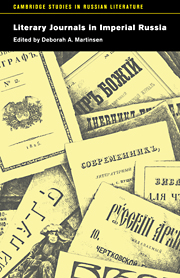Book contents
- Frontmatter
- Contents
- Notes on contributors
- Acknowledgements
- 1 Introduction
- PART I EIGHTEENTH CENTURY
- PART 2 EARLY NINETEENTH CENTURY
- PART 3 MID NINETEENTH CENTURY
- PART 4 SILVER AGE
- 9 Rise and decline of the “literary” journal: 1880–1917
- 10 The literary content of The World of Art
- 11 Northern Herald: from traditional thick journal to forerunner of the avant-garde
- 12 Chekhov and the journals of his time
- List of titles of journals and almanacs
- Select bibliography
- Index
- CAMBRIDGE STUDIES IN RUSSIAN LITERATURE
10 - The literary content of The World of Art
Published online by Cambridge University Press: 11 March 2010
- Frontmatter
- Contents
- Notes on contributors
- Acknowledgements
- 1 Introduction
- PART I EIGHTEENTH CENTURY
- PART 2 EARLY NINETEENTH CENTURY
- PART 3 MID NINETEENTH CENTURY
- PART 4 SILVER AGE
- 9 Rise and decline of the “literary” journal: 1880–1917
- 10 The literary content of The World of Art
- 11 Northern Herald: from traditional thick journal to forerunner of the avant-garde
- 12 Chekhov and the journals of his time
- List of titles of journals and almanacs
- Select bibliography
- Index
- CAMBRIDGE STUDIES IN RUSSIAN LITERATURE
Summary
The World of Art [Mir iskusstva, 1898–1904) was first and foremost an art journal and not a literary journal. It was founded to extend the work of the exhibition society also known as “The World of Art” through the publication of lavishly reproduced art materials of all sorts. The choice of works to be reproduced struck a balance between Russian and European art, but above all the journal sought to introduce the Russian public to new artists. In this it did not do a perfect job; it showed a better acquaintance with the contemporary styles known as art nouveau and Jugendstil than it did with Impressionism or early Post-Impressionism, for instance (though these deficiencies were partly repaired in 1903–4, when Igor Grabar became influential). In an early issue of the journal there is an obituary for the French artist Puvis de Chavannes, who died in 1898; his name is linked ostentatiously with those of Beethoven and Wagner! But the journal did place a very strong emphasis on new art; this in spite of the fact that its Russian program included both Old Russian art and Russian folk art. Finally, The World of Art was concerned with the applied arts, though it was clear that these could not really be integrated into a journal that was primarily a product of connoisseurship and did not include technical expertise in its editorial board.
How was literature to fit into such a program? It was clear that Diaghilev's own thinking in 1898 was very largely programmatic and pragmatic.
- Type
- Chapter
- Information
- Literary Journals in Imperial Russia , pp. 197 - 206Publisher: Cambridge University PressPrint publication year: 1998



